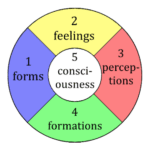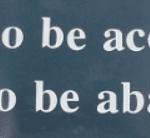
- 4 basic methods to meditate for Anxiety
- Mindfulness
- Illusory thoughts meditation for anxiety
- Tonglen meditation for anxiety
- Space Meditation for anxiety
- Best Mantra Meditation for Anxiety
- Transformation Meditation for Anxiety
Table of Contents
4 methods to meditate on anxiety
- Mindfulness Meditation
- Illusory thoughts meditation
- Tonglen – sending and taking
- Space
Mindfulness meditation for Anxiety
Mindfulness meditation is typically meditating on the breath, which will calm and soothe the mind, and developing a habit of doing so. This method will definitely help to diminish anxiety for the duration of meditation. If done somewhat more extensively, say an hour to two hours a day, with a morning and night sandwich dividing it up, it will create a more stabilizing effect.
Illusory Thought Meditation for Anxiety
The second method, which can be incorporated within the first one, is meditation for anxiety on the illusory nature of thoughts. Anxiety is a thought in the mind. It’s not to say that it’s not more powerful than most thoughts, but that the feeling of the body being excited or agitated turns into a thought, “This is anxiety.”
Even if the thought is unspoken in such a coarse manner, it’s still thought of as anxiety. It’s a secondary thought of, “This is not going to end. I am going to go crazy from this.” Those are very common thoughts of people with anxiety. Meditating on those thoughts, and less overwhelming thoughts, or ordinary thoughts, is very helpful in overcoming anxiety. In other words, we’re seeing through the seeming solidity of the emotions that we call anxiety, and the idea that this is a fixed, concrete, unchanging situation.
Tonglen – sending and Taking Meditation for Anxiety
The third method comes from the Mahayana, and it is called tonglen. It’s good to develop a basis in the first two meditations above, and an ability to see through the thoughts as fixed ideas, before incorporating tonglen.
In this approach, we arouse compassion. Tonglen means Sending and Taking. Instructions:
Send out good wishes and take in the pain and suffering of other beings. We meditate that we’re going to have to deal with this anxiety, so it would be better if it was beneficial, if it did something good for the world. We take in the pain and suffering and anxiety of others, thinking, “By taking their pain in, may it be karmically ripened, may all of their suffering of anxiety come to fruition, may the karmic issues be purified while I meditate on this anxiety right now. May it grow as big as it needs to release the pain of others.”
In your mind, realize that the anxiety is empty of being any particular thing, it’s really just energy at its root level. Now transform that anxiety into something positive, into good life energy, and light, and send it back out to all beings.
That light comes back to you in the form of darkness after drawing out the pain and suffering of other beings. You take it in.
Some people are anxious about this and afraid of it, but it turns out to be powerful at reversing the insularity of the focus, the fear that this anxiety is going to overwhelm you. You’re flipping the script on that and saying, “Bring it on. I can take it because I am benefiting others.”
You’re not afraid of the anxiety, so the fear goes away.
By assuming that you’re not afraid of it, you become not afraid of it. It’s a little bit of a magic trick, and surprisingly, one that works.
Space Meditation for Anxiety
The fourth method is to give it infinite space. One of the main issues with anxiety is that we tend to clamp down on it, to crush it into as small a volume as possible. It’s frightening. We’re afraid we’re going to be overwhelmed. There’s a feeling that everything is off -some kind of weirdness about the world.
I’ve been there. I understand what it’s like, so I’m not saying this from the outside. I’m writing from memory. I still experience anxiety from time to time. Everyone does. Trying to squeeze it down so that we squish it away into nothing only makes it vibrate harder.
It’s like Boyle’s law, where heat equals pressure times volume. If you squeeze a gas smaller, it becomes hotter without adding any heat to it, just because it has less space for the molecules to bounce around in so they begin to move faster. In this case, by trying to force the anxiety to go away, we make it more powerful in this small space. Reverse that.
Meditate for anxiety giving as much space as it wants. Give it all the space in the universe. Let it grow as big as it wants. As it does so, the pressure of it will decline. The heat of it will cool off. And it will not grow out of all proportion to become more powerful and bigger and bigger, which is what we’re afraid of.
The opposite will happen. It may expand and feel a little anxious, but this will go away very quickly, within 30 seconds, or a minute. Just let it keep growing. Remember, it’s got no boundaries, so it’s fine to let it go as far and as wide as it wants. Just let it dissipate. The universe is endless, and there’s no way you’re going to fill up the entire universe with your anxiety. It’s not even remotely conceivable.
You couldn’t even fill up your whole house with it. It’s fine. So when you let it go, and let it extend beyond the walls of your house and places, wherever it needs to go, it will dissipate and soften and become less and less of a problem.
Free course on how to meditate on anxiety.
If you want something more thorough, there are many, many more techniques, and they can be applied in your life – meaning off the cushion in active situations. Most require some kind of a formal meditative process, which is then incorporated into the mind and stabilized, so it will activate when you are in an anxiety-inducing situation. You can have that meditation arise spontaneously at that point. Check it out. The first few lessons are free, but they are potent, and hopefully they’ll work for you. They do work for most people.
Best Mantra Meditation for Anxiety
The best mantra meditation for anxiety is Tara’s mantra. Tara is a Buddhist deity. She was born from one of Aviloketeshvara’s tears. She swore to take rebirth in a female body to benefit people in ways that only a female Buddha could. Her specialty is protecting beings from fear, so it’s a natural thing, anxiety being a type of fear. Her basic mantra and longer mantra are
Om Tare Tuttare Ture Svaha
Om Tare Tuttare Ture Mama Ayuh Punya Jñana Pustim Kuru Svaha
It is probably helpful to visualize Tara in front of you, blessing you with cool, soothing white light as you do this. And then chant one or more malas of 108 beads of the mantra as a short meditation. 10 malas would probably only take 20 or 25 minutes.

Tara often has seven eyes. She has eyes in the three eyes on the face, the two normal ones, and then the third eye that you’re probably familiar with. And also eyes in the palms of her hands and the soles of her feet. She’s typically white.
There’s also a green version where she helps with illness, but in this case, she would probably be white and protecting from fear. The eyes on her palms and feet, in fact, all seven eyes, are so that she can see the suffering of the world. No suffering escapes her.
Tara is made out of light. She’s not a physical being. Remember, this is good to know that this is your own mind generating a visualization, but it’s also aided by the Buddha nature of the universe. In the Buddhist theory, there is a self-existing substrate called Buddha nature. It’s non-physical, but it’s vibrant and alive, it’s luminous.
Calling upon that, you can bring forth this kind of contextual help. It’s very difficult to directly contact the Buddha nature – the tathagatagarbha. However, you can call it forth in a visualized image. That’s essentially what you’re doing with visualizations. You’re calling forth the Buddha nature into an anthropomorphic form.
In doing so, it’s happy to comply. It uses your own mind, your own concepts to call that forth. And then that can be a connection between you and the Buddha nature. And that can soothe you. It can purify not only the anxiety, but the underlying tendency to anxiety.
Transforming Meditation for anxiety
You can transform anxiety in meditation by seeing that it doesn’t have a specific substance. Anxiety is not a thing. It’s not a physical reality. It’s a set of bodily and mental processes that combine together, that we tend to call anxiety and solidify as a mental existent.
By meditating on the anxiety is not being solid, but instead using the four foundations of mindfulness. Especially mindfulness of body, mindfulness of mind, the physical components, and the mental components. By seeing this clearly, we see that anxiety is none of those things. If we isolate any one of them, it would simply be a thought of anxiety without the feeling of it.
You can think of anxiety right now without experiencing the sense of anxiety. If we just isolate the agitatedness, then it’s the high energy. That’s not so different from being like a child who is overly enthusiastic.
Enthusiasm and anxiety are very similar bodily sensations. A thought process turns this energy back into one’s self, making it anxiety. The combination of those things is really what anxiety is.
The sense that this horrible feeling is going to come back and plague you forever, that there’s nothing you can do about it, is what turns into an anxiety attack.
Notice those parts. Break them out. In doing so, you can transform the key elements of this into something completely different, perhaps even its opposite. There’s much more on that in the course on Meditation for Anxiety.
There are a number of methods to transform anxiety. One method can generate almost endless ways to transform it. In a sense, this gamifies the process. It turns it into a type of play. In working with your anxiety, rather than, “Oh, I’ve got have to do something or else I’ll go crazy,” it’s a sense of opportunity to work with your mind. It can be actually fun, if I can say that. It might still be painful, but you can have fun doing it. That is possible.
Buddhism for depression and anxiety.
The Buddhist teachings aren’t specifically focused on depression and anxiety, but it turns out that they’re extremely useful for that. One of the best things, surprisingly, is the teachings on the Four Noble Truths.
The first Noble Truth is that existence is suffering, which sounds like it would create depression. And the cause of suffering is our own ego, our own self, which sounds like it might create anxiety. But it turns out that the opposite is true. It’s, in a sense, just some honesty about the situation, finally. By learning about the Four Noble Truths and meditating on them, it’s possible to progress along a path and to soften and relax the tendencies toward depression and anxiety. More on that in the Course 2.
Buddhism for stress and anxiety
The Dharma, or the teachings of the Buddha, focus generally on the Four Noble Truths and the general suffering. But one way to defuse stress, is to understand that life is suffering. So meditating, as in the previous section, on the Four Noble Truths, especially the First Noble Truth, is very helpful.
Existence is suffering. It does not mean that all of existence is 100% suffering. There’s joy, there’s love, there’s warmth, there’s dignity, there’s all the beautiful emotions in existence. What existence is suffering means is that no existence is free of suffering, and within every existence there is the seed of suffering. This is the link between anxiety and stress.
Anxiety can be seen to be the third type of suffering. The all-pervasive suffering. This sounds remarkably similar to what’s called free-floating anxiety, a very common problem in modern societies. Free-floating anxiety is an anxiety that’s not attached to any particular object. You’re not anxious because of your job, because of your children, your relationship, because of even the state of the world.
This anxiety doesn’t have a place. It’s there without any reference point. This is extremely difficult for people to manage. When you have the context of this third type of suffering, the all-pervasive suffering, and meditate on that, it can be tremendously helpful to overcome free-floating anxiety. There’s a lot more on this in the Course.
Buddhism for fear and anxiety
In Buddhist teachings, fear is actually fear of losing the ego. That’s what fear of death primarily is. If someone is not afraid of losing their ego, they probably won’t be afraid of dying either.
It can be very helpful to meditate on egolessness or selflessness. This is also called soso htarpa, liberation from suffering. Liberation from fear is the ultimate liberation from suffering. Studying the nidanas and karma is very helpful, and studying the skandhas is very helpful for defusing the intense fear of the loss of self.
One of the other fears is that the self is not truly existent, that we’re out of sync with reality itself, and that creates a certain fear in our mind. We’re disjointed with the truth. If you don’t understand that you don’t truly exist, then you’re not in touch with your true self, your genuine self. You’re disconnected from yourself. That can create a lot of anxiety and fear. It can even create panic.
That intense fear is associated with people who are extremely sensitive to nuance but don’t have a proper view to contextualize it. If they did, they could overcome much of that. Their fear and anxiety are based on genuine insights, but they have no way of grounding that insight and stabilizing it.
Insight can be destabilizing to a mind that’s not inherently stable. In that case, it’s extremely important to first work on good shamatha. Please check it out.
Conclusion of meditation for anxiety
Check out the course called Meditating for Anxiety. The first few lessons are free. There is a lot in those first few lessons. The advanced course is longer, but there’s a lot more and much deeper technique. It’s somewhat more advanced. If the first few courses don’t fully resolve the issue, then consider doing the consider the longer course.
Buddhist Prayer – Meditation for Anxiety
The best Buddhist prayer for anxiety is probably the Metta prayer. Metta, or maitri, means loving-kindness. The usual formulation is
May all beings be happy
May all beings be peaceful
May all beings be safe
May all beings awaken to the light of their true nature
May all beings be free
The key to this prayer is shifting focus from oneself to others. Much of the intensity of anxiety arises from self-concern (or concern for one’s children and loved ones). Moving away from specific individuals to all beings has a vastness which creates a soothing effect.
Song version of the Metta Prayer:








